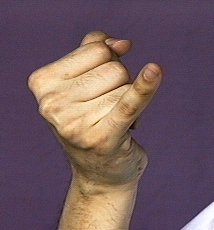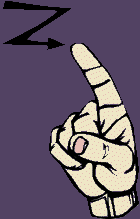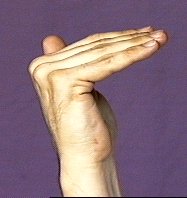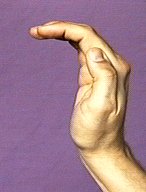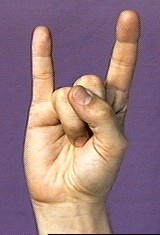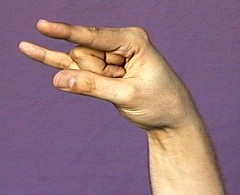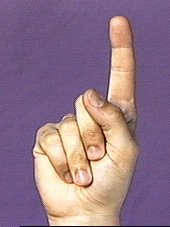American Sign Language: Handshapes
A student wrote: "I was looking at some of the signs, but couldn't tell which way my hands should be facing. For example one of the versions of the sign pizza uses a "p" handshape. Is the "P" facing me or the person I'm signing to?"
Dr Vicars: When fingerspelling, in general the palm of your hand faces toward the watcher. For the sake of comfort your palm is actually pointed a bit off to the right of the person to whom you are spelling. (Unless you are left handed, then it will be opposite.)
Letters like G, H, and P point a bit off to the right of the person to whom you are signing. Some signers point these letters almost directly to the left. Both methods are "okay." Use a position that feels comfortable to you yet is clear to the observer. In most sign language dictionaries, unless it says or shows otherwise, you can assume the sign is angled toward the watcher. It is important to note though that sometimes when you aim a sign at yourself or move a sign toward yourself you are doing so to create additional meaning. (Mine vs yours / done to me vs done to you.)
A:

B:
"B" Version 1:The thumb of the letter "B" generally has a "slight" bend, but not as much as depicted in most books.
The picture of "B" in my http://asl.ms website was taken in a series as I was spelling the ABC's.You might notice that a "B" being produced after an "A" tends to have little or no bend.
If you videotape a skilled signer fingerspelling the word "about" at high speed, the "B" will generally have little or no bend in the thumb. If you video record that same person spelling of the term "MBA" the "B" will have a very noticeable bend. Here's how I do the letter "B" in general:
-----------------------------------------------------------------------------------------------------------
"B" Version 2:
Some people cross the thumb over the palm. I don't do it this way because it takes too much effort. (Hey, I'm not lazy, just efficient.) This is how most "books" show it:
Shannon: What is a "b" palm? It doesn't relate to signing the letter "b" right?
DrVicars: When used to describe a sign, a "b" palm is like the letter "b" but you don't have to bend the thumb around onto the palm. The thumb is just alongside the palm in a natural position, with the fingers touching each other (side by side, extended). Think of a traffic cop telling oncoming traffic to stop.
Shannon: Okay that's what I guessed; just wanted to make sure.
"Classifier B," "Flat hand," or "B palm."
This handshape uses a "B" hand with the thumb alongside instead of folded across the palm. This handshape is used to describe flat, rectangular objects or surfaces.
Examples: - The roof of a house, a sheet of paper, a table, walls, ... etc..
You may also see this handshape showing up after the letter "A" during very fast spelling of words that have an "AB" combination.

C:
When used as a size and shape specifier this handshape shows things that are round or cylindrical.
Examples: pole, cup, or telescope.
This handshape can also be used to specify placement. You could show where certain things are in a room. For example, a TV or a microwave.
To describe a TV or microwave you could use index fingers to trace its outline, or b-hands to show its size and shape.
D:

E:
You might see an "e" that rests only three fingers on top of the thumb when someone is spelling a name or a word that places the letter "m" before the "e." For example: "James."
Or suppose you spell the name "J-A-N-E?" The "E" might end up looking like this:

There is even a version of "E" that uses only "one" finger (the index finger" perched on top of the thumb. This version often shows up after the letter "L."
Note: Sometimes you'll see people do an "e" with an opening between the fingertips and the thumb. I sometimes call that a "screaming E" or a "Hearing person's E." (Some people call it a "bear claw E." However it is fairly common in the Deaf Community and even used by quite a few Deaf people. I recommend that ASL teachers stay flexible. I also recommend we not consider it "wrong" but simply another version of "E" that shows up from time to time -- particularly after the letter "C" when some people spell the word "ICE."
F:
Tip: Do "not" get hung up on debating if the tip of the finger is on top of the thumb or the pad of the index finger is on top of the thumb. The exact form of an "F" varies a bit depending on surrounding letters. However -- some people care "a lot." If you have the unfortunate experience of being taught by such a person just smile and do it their way.
G:
You'll also see a "G" done with the thumb jutting up. That is just another variation.
H:
You'll also see an "H" done with the thumb jutting up. That is just another variation.
I:

J:








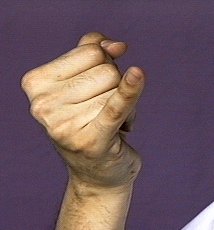
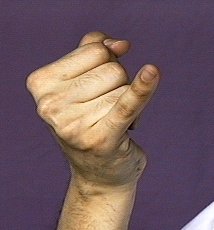
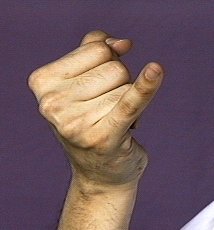
K:

L:

M: Three fingers draped over the thumb.
In books you often see the fingers draped way over the thumb, like this:
You'll see it both ways, but think about which version would naturally become more popular over the years due to ease of use.. It takes extra time to drape the fingers further over the thumb. So you can see why the "loose method" is more popular amongst everyday users of ASL.When most skilled signers fingerspell letters like "M, N, & T," they don't bend or wrap the fingers as tightly as the "ABC" alphabet charts tend to depict. The same for not bending the thumb over the palm in the letter "B." Tightly wrapping the fingers over and/or around each other takes too much time. An artist has a long time to draw pretty handshapes. The artist can paint them carefully and in perfect form for the sign language dictionary pages. A Deaf person whips out a several letters per second because he is trying to get his message across rather than impress somebody with how pretty his handshapes are.
N: Version 1:
Version 2:

O:
P:
In some parts of the country you will see a "p" done like this:

Q:

R:

S:

T:

U:

V:
W:

X:

Y:

Z:
Bent V handshape:
Uses: Things with legs, people and animals that are crouching, small animals
Examples:
- a small animal such as a squirrel
- a person sitting in a certain location (when done palm facing downward)
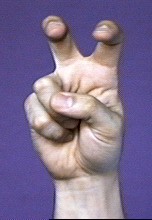
A "Bent V" is also good for doing a "double z."
Bent hand:
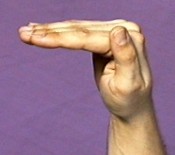
Claw hand:
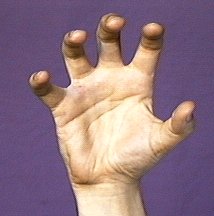
Closed hand:Fist or "S hand" or "closed hand"
Curved hand:
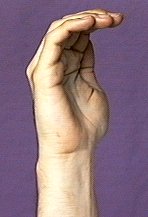
Horns:
Index:
Cocked Index:
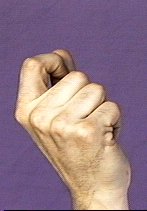
"Open hand" or "5 hand"

NEW! Online "ASL Training Center!" (Premium Subscription Version of ASLU) ** CHECK IT OUT **
Also available: "ASLUniversity.com" (a mirror of Lifeprint.com less traffic, fast access) ** VISIT NOW **










